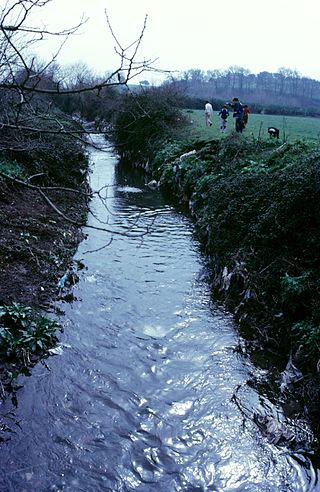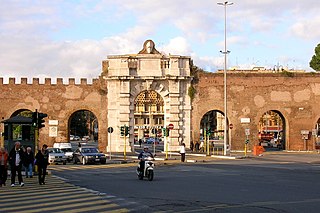
The Appian Way is one of the earliest and strategically most important Roman roads of the ancient republic. It connected Rome to Brindisi, in southeast Italy. Its importance is indicated by its common name, recorded by Statius, of Appia longarum... regina viarum . The road is named after Appius Claudius Caecus, the Roman censor who, during the Samnite Wars, began and completed the first section as a military road to the south in 312 BC.

Egeria was a nymph attributed a legendary role in the early history of Rome as a divine consort and counselor of Numa Pompilius, the second king of Rome, to whom she imparted laws and rituals pertaining to ancient Roman religion. Her name is used as an eponym for a female advisor or counselor.

Herodes Atticus was an Athenian rhetorician, as well as a Roman senator. A great philanthropic magnate, he and his wife Appia Annia Regilla, for whose murder he was potentially responsible, commissioned many Athenian public works, several of which stand to the present day. He was one of the best-known figures of the Antonine Period, and taught rhetoric to the Roman emperors Marcus Aurelius and Lucius Verus, and was advanced to the consulship in 143. His full name as a Roman citizen was Lucius Vibullius Hipparchus Tiberius Claudius Atticus Herodes.
Formia is a city and comune in the province of Latina, on the Mediterranean coast of Lazio, Italy. It is located halfway between Rome and Naples, and lies on the Roman-era Appian Way.

Appia Annia Regilla, full name Appia Annia Regilla Atilia Caucidia Tertulla, was a wealthy, aristocratic and influential Roman woman, who was a distant relative of several Roman emperors and empresses. She was the wife of the prominent Greek Herodes Atticus.

Capo di Bove is an archaeological site on the Appian Way on the outskirts of Rome, Italy. It contains the thermal baths of a vast property owned in the 2nd century AD by Herodes Atticus and his wife Annia Regilla.
Appius Annius Trebonius Gallus, sometimes known as Appius Annius Gallus was a Roman senator and consul.

Atilia Caucidia Tertulla was an aristocratic woman from Ancient Roman society.
Appius Annius Atilius Bradua was a Senator of the Roman Empire in the 2nd century AD.

Marcia Annia Claudia Alcia Athenais Gavidia Latiaria, otherwise most commonly known as Athenais (143-161) was a Roman noblewoman of Greek Athenian and Italian Roman descent who lived in the Roman Empire.
Appia Annia Claudia Atilia Regilla Elpinice Agrippina Atria Polla otherwise most commonly known as Elpinice (142-165) was a Roman noblewoman of Greek Athenian and Italian Roman descent who lived in the Roman Empire.
Tiberius Claudius Marcus Appius Atilius Bradua Regillus Atticus, otherwise known as Atticus Bradua, was a Roman politician of Athenian and Italian descent who was consul ordinarius in 185 AD.

The church of Sant'Urbano alla Caffarella is found on the edge of the Caffarella Park in the southeast of Rome. It was originally a Roman temple. In the 10th century, the structure was modified and consecrated as a church and it was extensively altered in the 17th century.
Rediculus is an ancient Roman divinity. His cult had a temple near the Porta Capena, and a campus on the Appian Way.

Quarto Miglio is an urban zone of Municipio VII of Rome, Italy. It was located in the south-eastern area of the city. As of 2010 it had a population of 11,052 people. It takes its name from its proximity to the 4th Mile of the Appian Way, which borders it to the southwest, and is close to much of the Appian Way Regional Park. Many of its street names come from ancient Romans connected with the area, including Herodes Atticus and Annia Regilla. In Roman times the area was known as "ad Quartum".

The Villa dei Sette Bassi was the second-largest ancient Roman villa or monumental palace in the suburbs after the Villa of the Quintilii.

The Appian Way Regional Park is the second-largest urban park of Europe, after Losiny Ostrov National Park in Moscow. It is a protected area of around 4580 hectares, established by the Italian region of Latium. It falls primarily within the territory of Rome but parts also extend into the neighbouring towns of Ciampino and Marino.

The Almone is a small river of the Ager Romanus, a few miles south of the city of Rome. Today the river is polluted and is channelled to a sewage treatment plant and no longer reaches its natural confluence with the Tiber.

Municipio Roma VII is the seventh administrative subdivision of the Municipality of Rome (Italy).

Appio-Latino is the 9th quartiere of Rome (Italy), identified by the initials Q. IX. The name derives from the ancient roads Via Appia and Via Latina. It belongs to the Municipio VII and Municipio VIII.



















